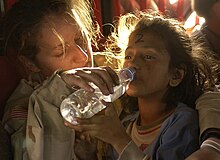Humanitarian aid

Humanitarian aid (also called succour) is material or logistical assistance provided for humanitarian purposes, typically in response to humanitarian crises. The primary objective of humanitarian aid is to save lives, alleviate suffering, and maintain human dignity. It may therefore be distinguished from development aid, which seeks to address the underlying socioeconomic factors which may have led to a crisis or emergency.
Humanitarian response
Humanitarian aid is delivered by governmental agencies, non-governmental organizations, and other non-governmental humanitarian agencies according to humanitarian principles set out in Resolution 46/182[1] of the United Nations General Assembly (for governments and UN agencies), and in Code of Conduct for the International Red Cross and Red Crescent Movement and NGOs in Disaster Relief (for NGHAs).
Funding
They are funded by donations from individuals, corporations, governments and other organizations. The funding and delivery of humanitarian aid is increasingly being organized at an international level to facilitate faster and more effective responses to major emergencies affecting large numbers of people (eg. see Central Emergency Response Fund). The United Nations Office for the Coordination of Humanitarian Affairs (OCHA) coordinates the international humanitarian response to a crisis or emergency pursuant to Resolution 46/182 of the United Nations General Assembly.
Standards
HAP Standard 2007
Humanitarian Accountability Partnership International
Working with its partners, disaster survivors and others, HAP-International produced the HAP 2007 Standard in Humanitarian Accountability and Quality Management. This certification scheme aims to provide assurance that certified agencies are managing the quality of their humanitarian actions in accordance with the HAP standard. [2] In practical terms, a HAP certification (which is valid for three years) means providing external auditors with access to the organization’s mission statement, accounts and control systems, providing for greater transparency in operations and overall accountability. [3] [4]
As described by HAP-International, the HAP 2007 Standard in Humanitarian Accountability and Quality Management is a quality assurance tool for humanitarian organizations. By comparing an organization's processes, policies and products to the Standard's six benchmarks, it is possible to measure how well the organization assures quality and accountability in its humanitarian work. Agencies that comply with the Standard:
- declare their commitment to HAP’s Principles of Humanitarian Action and to their own Humanitarian Accountability Framework
- develop and implement a Humanitarian Quality Management System
- provide key information about quality management to key stakeholders
- enable beneficiaries and their representatives to participate in program decisions and give their informed consent
- determine the competencies and development needs of staff
- establish and implement complaints-handling procedure
- establish a process of continual improvement [5]
The Sphere Project handbook, Humanitarian Charter and Minimum Standards in Disaster Response, which was produced by a coalition of leading non governmental humanitarian agencies, lists the following principles of humanitarian action:
- The right to life with dignity
- The distinction between combatant and non-combatants
- The principle of non-refoulement
The Quality Project, based on the Quality Compass, is an alternative project to Sphere, taking into account the side effects of standardization and those of an appraoch based on "minima" rather than the pursuit of quality. This project is leaded by Groupe URD.
Safety
Every organization participating of humanitarian aid operations, has its own particular rules, regulations and preventive plans of action for keeping their aid workers as safe as possible. Nevertheless, the dangers and threats inherent to these kind of operations have always existed and are not easy to minimize as each field of operation is unique. Even in areas with relative calm and tranquility, violence can suddenly appear.[6]
Notes
- ^ A/RES/46/182
- ^ Capacity.org - A Gateway for Capacity Development
- ^ The Economist - Certifying Aid Agencies, 24 May 2007
- ^ Reuters Alernet Website - Can a certificate make aid agencies better listeners? 6 June 2008
- ^ HAP-International Website - The HAP 2007 Standard
- ^ Roberts, David Lloyd (1999). Staying Alive. International Committee of the Red Cross. p. 16. ISBN 2-88145-099-7.
References
- Larry Minear (2002). The Humanitarian Enterprise: Dilemmas and Discoveries. West Hartford, CT: Kumarian Press. ISBN 1-56549-149-1.
- Waters, Tony (2001). Bureaucratizing the Good Samaritan: The Limitations of Humanitarian Relief Operations. Boulder: Westview Press.
See also
Organisations
- Humanitarian Accountability Partnership International
- Médecins Sans Frontières, MSF (Doctors Without Borders)
- Mercy Corps
- AmeriCares
- CARE
- Malteser International
- International Red Cross and Red Crescent Movement
Organisation types
External links
- Active Learning Network for Accountability and Performance
- UN ReliefWeb
- AlertNet
- IRIN
- The ODI Humanitarian Policy Group
- The Center for Disaster and Humanitarian Assistance Medicine (CDHAM)
- Centre for Safety and Development
- EM-DAT: The International Disaster Database
- CE-DAT: The Complex Emergency Database
Critiques of Humanitarian Aid
- A Bed for the Night: Humanitarianism in Crisis interview with David Rieff and Joanne Myers
- Journal of Humanitarian Assistance Sean Greenaway: Post-Modern Conflict and Humanitarian Action: Questioning the Paradigm
